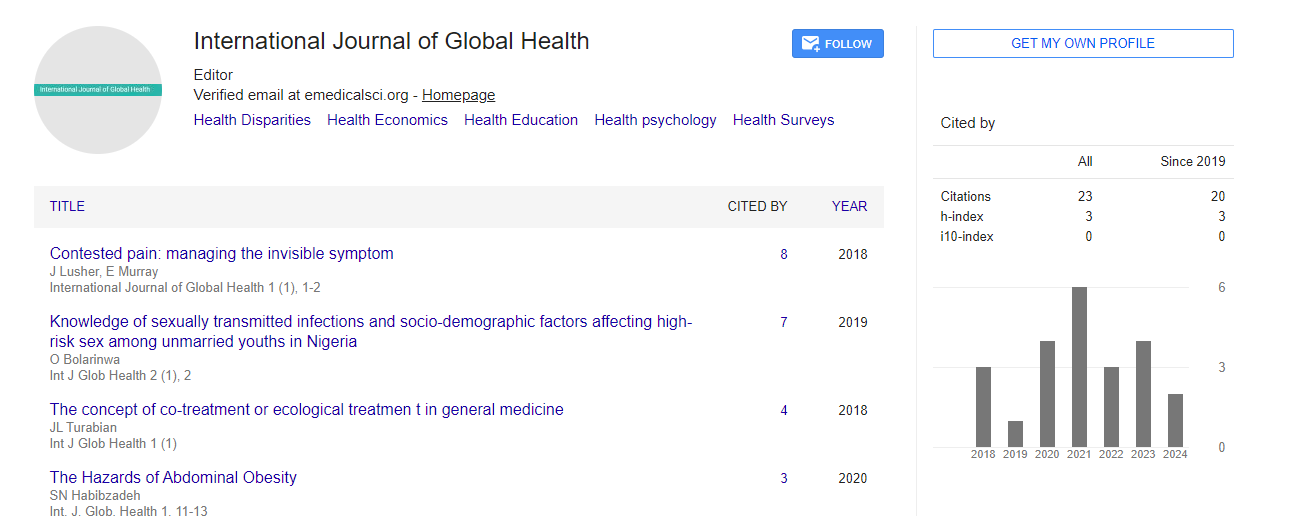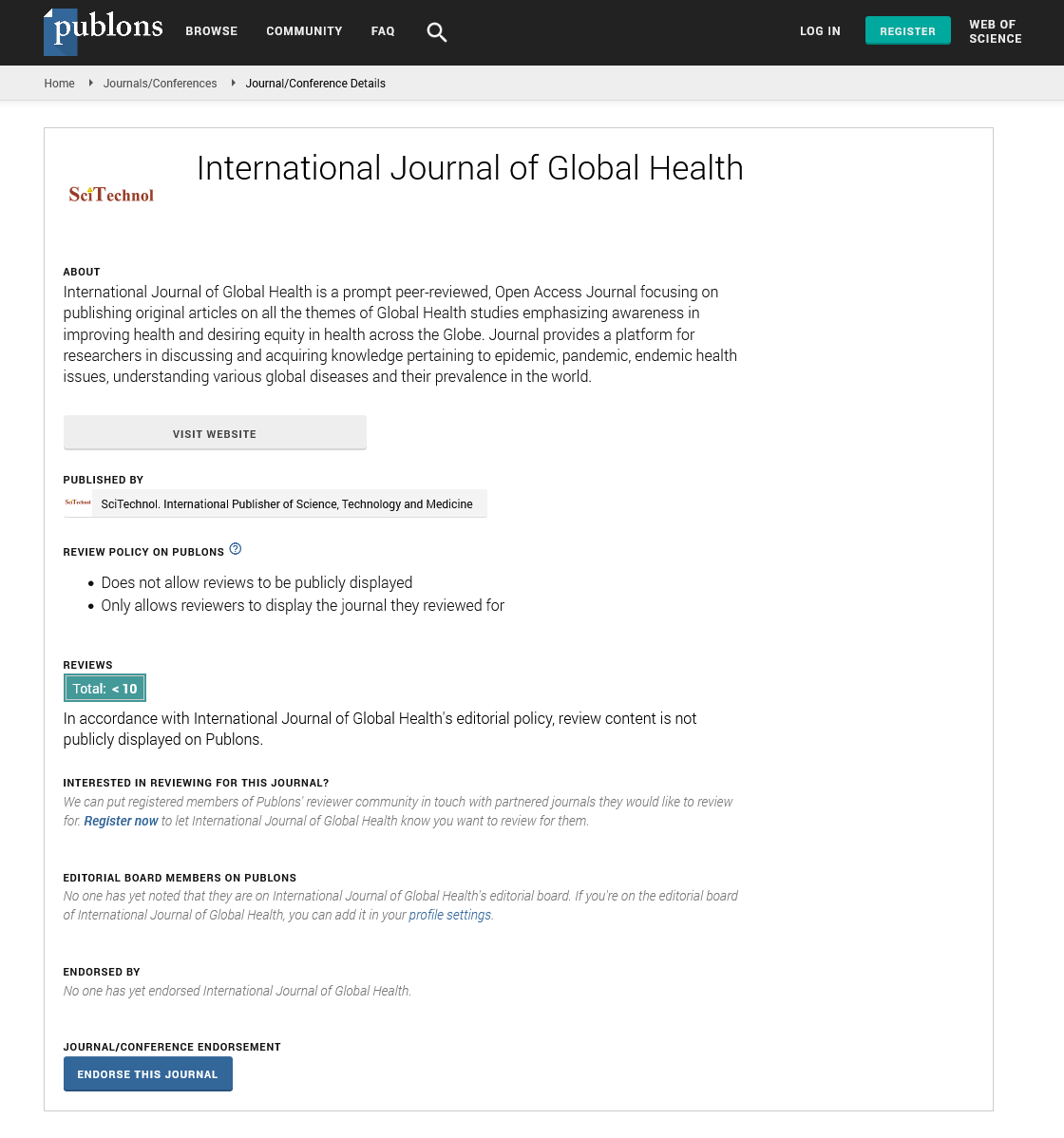Editorial, Int J Glob Health Vol: 4 Issue: 3
Health economics – An Overview
Khristen*
Family and Community Medicine Health Center Santa Maria de Benquerencia Regional Health Service of Castilla La Mancha (SESCAM), Toledo, Spain
- *Corresponding Author:
- Khristen
Family and Community Medicine Health Center Santa Maria de Benquerencia Regional Health Service of Castilla La Mancha (SESCAM), Toledo, Spain
E-mail: khrsten@hotmail.com
Received Date: May 14, 2021; Accepted Date: May 21, 2021; Published Date: May 28, 2021
Citation: Khristen (2021) Health economics – An Overview. Int J Glob Health 4:3. 135.
Copyright: © All articles published in International Journal of Global Health are the property of SciTechnol, and is protected by copyright laws. Copyright © 2021, SciTechnol, All Rights Reserved.
Abstract
Health economics may be a branch of economics concerned with issues associated with efficiency, effectiveness, value and behavior within the production and consumption of health and healthcare. Health economics is vital in determining the way to improve health outcomes and lifestyle patterns through interactions between individuals, healthcare providers and clinical settings. In broad terms, health economists study the functioning of healthcare systems and health-affecting behaviors like smoking, diabetes, and obesity.
Keywords: economicsHealth, economics, diabetes, and obesity
A seminal 1963 article by Kenneth Arrow is usually credited with giving rise to health economics as a discipline. His theory drew conceptual distinctions between health and other goods. Factors that distinguish health economics from other areas include extensive government intervention, intractable uncertainty in several dimensions, asymmetric information, barriers to entry, externality and therefore the presence of a third-party agent. In healthcare, the third-party agent is that the patient’s health insurer, who is financially liable for the healthcare goods and services consumed by the insured patient. Health economists evaluate multiple sorts of financial information: costs, charges and expenditures.
Uncertainty is intrinsic to health, both in patient outcomes and financial concerns. The knowledge gap that exists between a physician and a patient creates a situation of distinct advantage for the physician, which is named asymmetric information.
Externalities arise frequently when considering health and health care, notably within the context of the health impacts like communicable disease or opioid abuse for instance, making an attempt to avoid catching the cold affects people aside from the choice maker or finding sustainable, humane and effective solutions to the opioid epidemic.
In the third century BC, Aristotle, an Ancient Greek thinker, once talked about the connection between farmers and doctors in production and exchange. In the 17th century, William Petty, a British classical economist, acknowledged that the medical and health expenses spent on workers would bring economic benefits.
Nowadays, modern health economics has developed into a number one interdisciplinary science, which bridges the gap between theory and health care practice, and therefore the wide diversification in various sub-disciplines and research fields has been clearly visible. Few would argue that the particular cradle of this data was the tutorial tradition of the U.S.
The American Medical Association (AMA) was created in 1848, having as main goals scientific advancement, creation of standards for medical education, launching a program of medical ethics, and obtaining improved public health. Yet, it had been only in 1931 that economic concerns came to the agenda, with the creation of the AMA Bureau of Medical Economics, established to review all economic matters affecting the medical profession.
After the Second war, thanks to the rapid improvement of the extent of medical research technology, the modernization of diagnosis and treatment means and health facilities and equipment, the aging of the population, the sharp increase of chronic diseases, and therefore the improvement of people’s demand for health care and other reasons, the medical and health expenses increased significantly. for instance, total U.S. health expenditures steadily increased as a share of gross domestic product (GDP), demonstrating the increased importance that society places on health care relative to other non-health goods and services. During 1960 - 2013, the health spending share of GDP increased from 5.0 to 17.4 percent. Over an equivalent period, the typical annual growth in nominal national health expenditures was 9.2 percent compared to nominal GDP growth of 6.7 percent.
At an equivalent time, the expenditure on health care in many European countries is additionally increasing, accounting for about 4% of GDP within the 1950s; By the top of the 1970s, it had risen to eight. In terms of rate of growth , the proportion of health care expenditure in GNP in many countries increased by 1% within the 1950s; within the 1960s, it increased by 1.5%; It grew by 2% within the 1970s. The high medical and health expenditure may be a heavy economic burden on the govt , business owners, workers, and families, which objectively requires the rapid climb of medical and health expenditure to seek out how to restrain the expansion of health expenditure.
 Spanish
Spanish  Chinese
Chinese  Russian
Russian  German
German  French
French  Japanese
Japanese  Portuguese
Portuguese  Hindi
Hindi 
